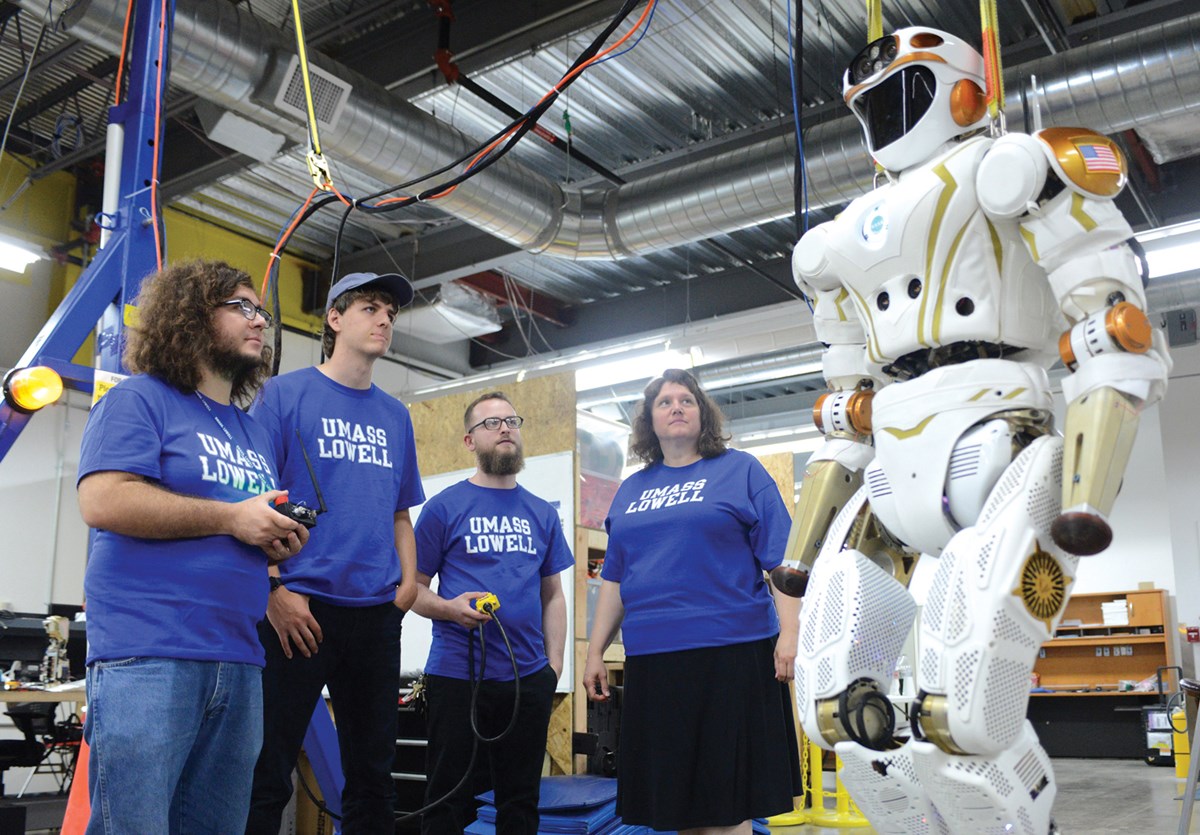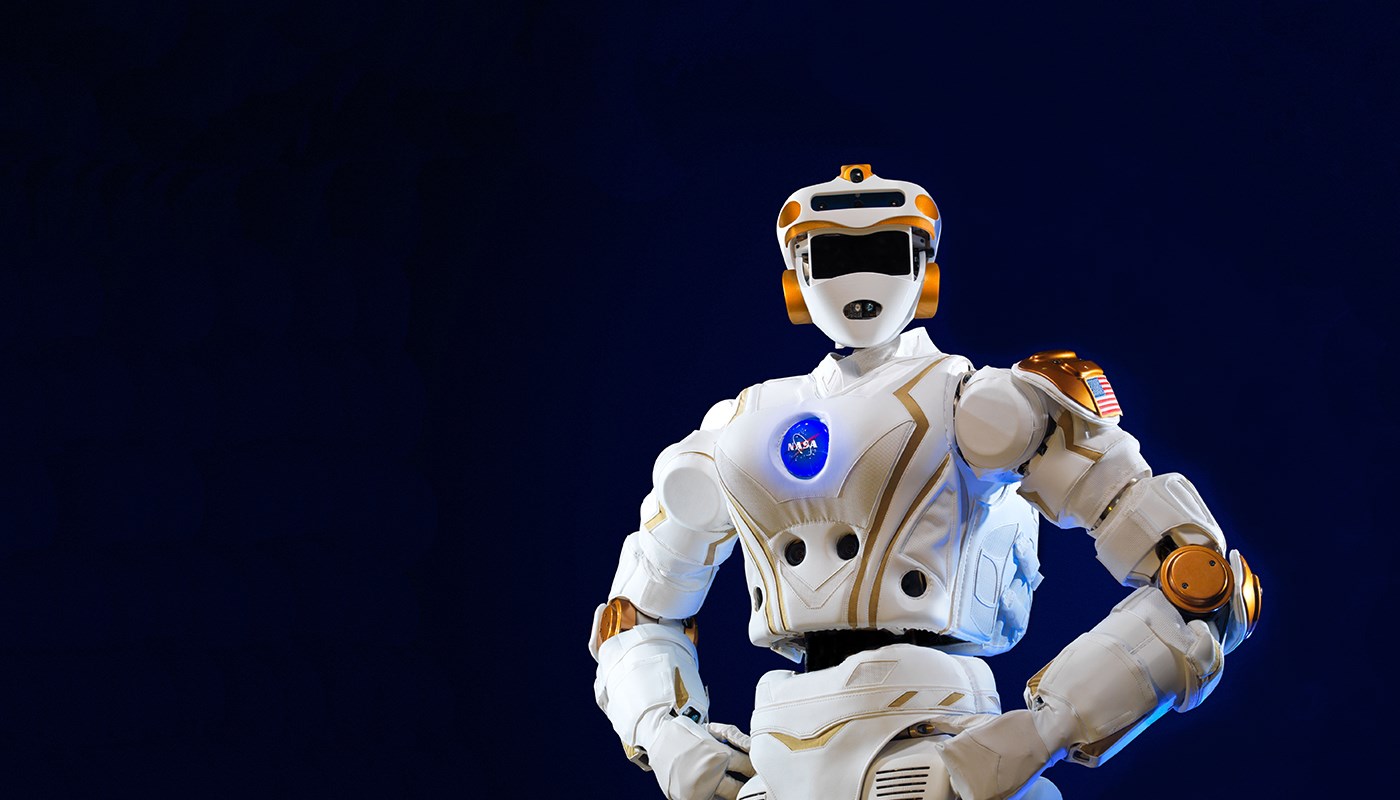“It’s amazing to have Valkyrie here,” says Yanco, who is leading a team of more than a dozen student researchers from UMass Lowell, in collaboration with Northeastern University, over the next two years to teach Valkyrie how to walk, manipulate objects and understand the world around her. “She falls sometimes, but we’re learning to program her to walk better and balance better.”
Valkyrie is actually a quadruplet—her three sisters reside at MIT, the University of Edinburgh in Scotland and NASA’s Johnson Space Center in Houston. Chen says that having one of four Valkyries in the world here on campus is a coup for the university. “Everyone can appreciate going to Mars,” she says. “It’s helpful in getting people to appreciate and understand science and technology.”
Since Valkyrie arrived on campus, the NERVE team has been painstakingly fine-tuning the algorithms that control her balance and motor functions, slowly teaching her to walk.
“It definitely makes me appreciate the human machine,” says Jordan Allspaw, an undergraduate computer science major who spent two weeks in January at the Johnson Space Center learning how to train and maintain an R5.
Computer science graduate student Carlos Ibarra Lopez, who in 2013 was part of the UMass Lowell “Rover Hawk” team that won NASA’s Robo-Ops competition in Houston, says that working on a groundbreaking project like Valkyrie is as thrilling as it is challenging.
“The idea that anything we’re working on would end up on Mars is pretty amazing,” says Ibarra Lopez, who also trained in Houston in January. “But since it hasn’t been done before, you can’t really just Google something to find how to solve problems. We have to contact NASA.”
While her NU counterparts, professors Taskin Padir and Robert Platt, are primarily focused on Valkyrie’s balance, movement and ability to grasp objects, Yanco is busy analyzing how the robot will interact with humans. Valkyrie can’t talk (yet), and although her black facemask may serve her well in a poker game, it doesn’t really let her convey emotions. For now, she relies on a glowing NASA emblem on her chest plate to communicate some basic concepts and interact with those around her.
“There’s a very broad range of human-robot interaction, which I find very interesting to think about,” Yanco says. “For less-capable robots, the interaction could be using a joystick to control a bomb disposal robot. If you’re talking Valkyrie on Mars, the interaction is a little different. It might have to send messages back to NASA saying it’s having trouble.
One of my grad students is running a survey on the internet to see what icons people could look at and say, ‘I understand it means the robot needs help.’”
And then there’s the question of how Valkyrie, or any autonomous robot, can best communicate with people around them who aren’t familiar with them. Yanco sees the impending proliferation of self-driving cars as the most obvious example of this problem.
“When we cross the street we make eye contact with the driver of a car. What do you do with an autonomous car? There’s no one to make eye contact with. How do you know it’s safe and they recognize that you’re there?” she says.
“As more and more autonomous systems are deployed, we need to understand what they’re doing. Are they moving? Are they not moving? Can we get near them? Should we not get near them?”
In addition to studying this human-robot interaction and validating the autonomous skills that Valkyrie would need for deep space missions, Yanco and her team are helping NASA develop test courses for the 2017 Space Robotics Challenge, in which teams from around the country will control a virtual Valkyrie through a series of tasks.
“There aren’t many other places in the world where I could be working with a robot like this,” Lopez says.
Socio-Economic Implications
Earlier this year, researchers and academics, including Sociology Department Chair and Assoc. Prof. Mignon Duffy, gathered at Mount Holyoke College for a conference on “The Future of Jobs: The Dual Challenges of Globalization and Robotization.” Duffy’s research focuses on care work such as health care, child care and education, one of the fastest growing sectors of the labor market.
“It’s also one of the most resistant to being fully automated, given the need for human responsiveness and relationships,” says Duffy, who is also associate director for the Center for Women and Work.
“The conference was specifically focused on work and workers, but I do think that is one of the major things we need to think about with the rise of artificial intelligence: How does this impact jobs as we know them? It has the potential to have a huge impact.”
While Duffy believes care jobs require “invisible pieces” such as human relationships and emotional responsiveness that even the most advanced robots just can’t imitate, she is concerned that the rise of artificial intelligence could change the way society thinks about those whose job it is to care for others.
“Since we often do not recognize and value the important emotional and relational work that people like teachers and nurses do, could we then try to reduce their jobs to a series of tasks that could be automated?” she says. “In some ways automation is the next stage of standardization; if we think something can be standardized, broken down into a series of tasks, then it can be automated.”
Looking 50 years down the road, Scott Latham, associate professor of management in the Manning School of Business, sees workplace automation creating an even wider socio-economic divide than exists today.
“There will be no more minimum-wage jobs. Robots will take over a lot of those jobs—everything from landscaping to working in restaurants to home care,” says Latham, who researches business strategy. “The jobs will be in industries like robotics and biotechnology, where higher knowledge workers are required. Unfortunately, that means there will be an even greater disparity in wealth.”
To counteract this disparity, Liu says that the workforce will simply need to adapt and keep learning new skills, just as it has always done when technology evolves.
“I think we’re in a unique position at UMass Lowell,” Liu says, “because of our technology advances and lifelong learning and job training, to provide these opportunities.”




